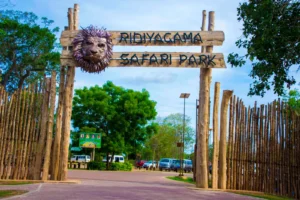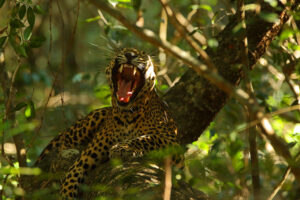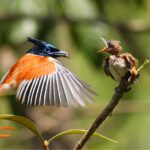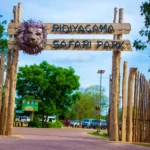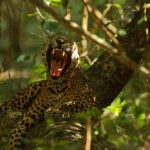A birder’s heaven, Sri Lanka. a tropical island in the Indian Ocean that is 10 degrees north of the equator and has a variety of favourable climates, as well as forests, grasslands, marshes, oceans, and agricultural fields. There are 439 species of birds in the nation, of which 236 are breeding residents, 203 are migratory, and the remainder are vagrants. With 33 endemic species and 68 unique subspecies of birds and a species endemism of 11% in a country as tiny as Sri Lanka, it is clear why Sri Lanka is one of the best birding destinations in the world. Included in this are endemic species such fowls, pigeons, parrots, parakeets, malkoha, coucal, owls, owlet, hornbills, barbets, magpies, bulbuls, warblers, babblers, thrushes, white-eyed mynah, starlings, and flycatchers, Flowerpecker, Pigeon, Barbet, Flameback, Woodshrike, Drongo and Swallow.
There are also up to 200 seasonal migratory species, both terrestrial and aquatic, that migrate south to avoid the harsh northern winters. These birds come from as far away as Siberia, Scandinavia, and Western Europe, and they arrive in the months of August and September and go in the months of April and May. Due to Sri Lanka’s location at the furthest southern point from the south of India and the absence of any other landmass till the South Pole, migratory birds often choose it as a wintering site. The Openbill, Ibis, Heron, Egrets, Pelicans, Comorant, Water-cock, Swamphen, Waterhen, Stilts, Duck, and Grebe are a few of the migratory birds.
The Kumana National Park, which is regarded as one of the most significant nesting and breeding sites in Sri Lanka, serves as the country’s primary bird refuge. A popular birding location, Bundala National Park is located at the southernmost point of the bird migration path and is home to large flocks of flamingos, herons, and storks. In addition to numerous tanks, reservoirs, lagoons, marshes, lakes, and rivers, the other locations include the Kalametiya Bird Sanctuary, Sinharaja Rain Forest, Bodinagala Forest Reserve, Peak Wilderness Sanctuary, Kitulgala Forest Reserve, Yala, Willpattu, Udawalawe, Wasgamuwa, Minneriya and Horton Plains National Parks in addition to numerous tanks, reservoirs, lagoons, marshes, lakes and rivers.
Aviyana Ceylone Tours Team offers keen insight and a unique perspective to some of the most famous Bird waching sites in Kumana, Wilpattu, , Kalametiya Bird Sanctuary, Sinharaja Rain Forest, Bodinagala Forest Reserve . Minneriya and Bundala National Parks, Horton Plains National Park, Thalangama Wetland, Ritigala mountains range, Chundikulam National Park, Kitulgala Forest Reserve ect.. Our team is a well trained passionate, dedicated and experienced team with a high professional background. Certainly, to provide you the best quality of service that brings you up to the extreme pleasure during your holiday. Furthermore, we provide attractions and activities that interest you while your stay in Sri Lanka. We can make arrangements to suit your own personal needs and interests. Most certainly, turn an ordinary trip into the experience of a lifetime
1. Sinharaja Rain Forest Reserve
Sinharaja Forest Reserve is a national park and a biodiversity hotspot in Sri Lanka. It is of international significance and has been designated a Biosphere Reserve and World Heritage Site by UNESCO.One of the most important natural habitats in Sri Lanka, the Sinharaja rainforest offers a huge diversity of species both flora and fauna with a large proportion of those being indigenous to the country and some more specifically endemic to Sinharaja itself. However, a permit is required to enter the reserve. A forest guide will be provided by the Forest Department. The ticket office at Kudawa can be reached by a car but a four-wheel-drive vehicle with a high ground clearance is needed to reach the forest entrance from which point bird watching has to be done on foot. The paths are well defined but one has to be mindful of the leeches, especially during the rainy season.
Sinharaja is famous for its mixed feeding bird flocks and a number of endemic Birds can be observed during the walks across the forest. Sinharaja Rain Fores Basic accommodation is provided by the Forest Department for those interested in staying overnight but it has to be arranged prior to the visit from the head office at Jayanthipura, Battaramulla. There are also a few private guest houses, which would provide meals and accommodation. There is an entry into the reserve from Deniyaya as well.
The Sinharaja forest was initially declared a Man and Biosphere Reserve (MAB) in 1978 as suggestive and has been recognized by UNESCO as the region of its International Network of Biosphere Reserves.The lush nature covers around 11187 ha passing the boundaries of three Districts, namely Ratnapura, Matara and Galle. This biosphere reservation is between north latitude 6º21´-6º27′ and east longitude 80º21´-80º37′. There are four passageways to pass into this forest: Ratnapura – Weddagala route, Ratnapura-Rakwana-Sooriyakanda-Ilumbakanda road, Hiniduma – Neluwa road and Deniyaya-Pallegama road. However, the reserves of this rainforest’s main entry from the Ratnapura side, most of the area belongs to Ratnapura District.
Birds
Green-Billed Coucal, Red-Faced Malkoha, Ceylon Blue Magpie, Rufous Babbler, Ceylon Hill Mynah, Ashy-Headed Laughingthrush, White-Headed Starling, Yellow-Fronted Barbet, Spot-Winged Thrush, Scaly Thrush, Ceylon Jungle Fowl, Ceylon Spur Fowl, Crimson-Backed Woodpecker, Ceylon Crested Drongo, La yard’s Parakeet, Ceylon Green Pigeon, Ceylon Lorikeet, Serendib Stops Owl, Ceylon Bay Owl, Ceylon Grey Hornbill, Chestnut Backed Owlet, Ceylon Frogmouth, Legge’s Flower pecker, Scimitar Babbler, Ceylon Trogon, Black Eagle, Crested Serpent Eagles, Hawk Eagles, Crested Honey Buzzard and many more.
2. Kumana National Park
Kumana National Park in Sri Lanka is renowned for its avifauna, particularly its large flocks of migratory waterfowl and wading birds. The park is situated southeaster coast of Sri Lanka. Kumana is contiguous with Yala. Kumana National Park is famous for its avifauna, particularly its massive flocks of migratory raptors and paddling birds. This Park is 391 kilometres southeast of Colombo on the south-eastern coast of Sri Lanka. Kumana is adjacent to Yala National Park. Kumana was previously known as Yala East National Park but turned to its present name on 05 September 2006.
Kumbukkan Oya forms the southern edge of the National Park. Some 20 lagoons and tanks hold the incredible birdlife of the national Park. The lagoons are shallow, with depths more limited than 2 metres. Kumana Bird Sanctuary, declared in 1938, is held within the Kumana National Park. Kumana is one of the several significant bird nesting and breeding grounds in Sri Lanka. Two hundred fifty-five species of birds have been regarded in the national Park. Thousands of birds relocate to the Kumana swamp area annually from April- July. Unique varieties such as the Lesser Adjutant, Eurasian Spoonbill, Black-necked Stork, and GreatThick-knee are breeding inhabitants of the Kumana.
3. Bundala National park
Bundala National park is found in the Hambantota District of the southern province. Bundala has initially declared a sanctuary on 05 December 1969 and was renewed into a National park on 4 th January 1993. This is the last home in the more numerous flamingo in this part of the island and is vital for elephants and a variety of threatened reptiles.
The Park contains five shallow, salty lagoons with salt pans in three interconnecting waterways and marshes, including the adjacent coast. This unique area of scenic lagoons and intertidal; mudflats where the wintering birds relax and feed, golden shores and dunes snubbed by nesting sea turtles. The Park is also a heaven for 149 resident migratory birds, and the region of the Park is 6,216ha. Plants are tropical and monsoonal, with a base annual temperature of 27 ° C. Annual rainfall ranges from 900mm to 1300mm, with an extended dry period from May to September.
4. Chundikulam National Park
Previously known as the Chundikulam sanctuary, presently, the Sri Lanka government-linked numerous forests nearby to formulate a larger protected zone as the Chundikulam National Park in 2015. The Park has widespread mangrove swamps and seagrass beds. Many birds in the Park are black-tailed godwit, black-winged stilt, brown-headed gull, common sandpiper, greater flamingos, and several others. Deer and crocodiles can be seen in the Park as well. The statement indicates that the leopards and bears live in the Chundikulam national park, but they are not easily found because they are not used to visitors and are very shy.
5. Gal Oya National Park
Gal Oya National Park was founded in 1954 to preserve the catchment area of the Senanayake Samudra, Sri Lanka’s most extensive inland form of water. It is among the most scenically stunning views in Sri Lanka, with the lake encircled by an inspiring backdrop of rocky, forested hillsides. Senanayake Samudra reservoir carries a critical fishery and is an excellent irrigation source.
Gal Oya National Park is a secluded wildlife park of over 25,000 hectares of dense evergreen forest and open savannahs alongside quiet Senanayake Samudra in the dry zone. Moreover, Gal Oya is the only national Park where boats lead safaris, allowing closer than usual wildlife encounters.
Gal Oya National Park is a habitat for 32 species, including langurs, toque macaques, leopards, sloth bears, wild boar, water buffaloes and deer, and about 150 birds of two distinct ecological categories, the fish-eating and fruit-eating species. Incredibly unique endemics, the Red-faced Malkoha and Sri Lanka Spurfowl, and the outstanding breeding occupant in the dry zone, the Painted Partridge, for which this region is the last refuge.
6. Kalametiya Bird Sanctuary
Kalametiya is a nearshore wetland region with a particularly rich bio-diversity situated along with Rekawa and Ussangoda in the district of Hambantota, Down South of Sri Lanka. The land of outstanding beauty is littered with considerable bays, lagoons, rocky outcrops and golden beaches, extending from around Tangalle to Hambantota.
Nourishing Sanctuary for a few remaining nationally endangered birdlife, bird watching in this significant location will make your trip to Sri Lanka. Furthermore, Find a broad range of wetland birds, such as Slatybreasted Crake, Black Bittern, Watercock Grey Mongoose, and Hanuman Langur.
7. Bodhinagala Sanctuary
Bodhinagala Sanctuary, also named Ingiriya Forest Reserve, is a secondary lowland rainforest patch in Kalutara District, 30 km from the West Coast. The Bodhinagala Forest is located to the southwest of Ingiriya town. The reserve covers a slightly hilly area of 20 hectares, stretching between the Panadura-Ratnapura main road A8 and the Kalu Ganga, one of Sri Lanka’s largest rivers, which is untouched and quite idyllic in this region.
The avifauna of Bodhinagala, home to 151 recorded bird species, is significant as one of the best sites to spot the Green-Billed Coucal, one of Sri Lanka’s rarest endemic bird species. Other endemic birds in Bodhinagala are Black-capped Bulbul, Ceylon Spurfowl, Yellow-fronted Barbet, Ceylon Small Barbet, Sri Lanka Hanging Parrot, Layard’s Parakeet, Sri Lanka drongo Sri Lanka Grey Hornbill, Spot-winged Thrush. Endemics to South Asia occurring in Bodhinagala are the Ceylon Frogmouth, Dark-fronted Babbler, and the Malabar Trogon. In addition, Emerald Dove, Crested Drongo, and Black-napped Monarch are common birds.
8. Weerawila Bird Sanctuary
Weerawila Bird Sanctuary is where the most impressive creatures come to gather. Birds lovers, Weerawila Bird Sanctuary, is found Down south of Sri Lanka near Tissamaharamaya and claims two major reservoirs; the Weerawila reservoir and the Tissa reservoir. Thousands of migrating birds come to the Sanctuary yearly to roost and nest. While travelling, keep an eye out for water birds like the lesser flamingo, the painted stork, the spoonbill, the grey heron, the darter, the purple heron and the rare black-necked stork. Migrating birds who visit the Park include the pintail, the Eurasian curlew, and the whimbrel. They harmoniously experience the space with the wetland part of the sanctuary inhabitants like the red-wattled lapwing, the excellent stone player, and other forest varieties such as the orange-breasted green pigeon, the hornbill, and the flycatchers.
9. Beddegana wetland park
Beddegana wetland park is located in Sri Jayewardenepura Kotte, and a highly urban built environment sets the stage for its paradigm significance. This 18-hectare area is home to many aquatic birds and other faunal species, such as butterflies, dragonflies, and mammals endemic to Sri Lankan and Asian wetlands. Apart from that, this marsh area is a popular stopover for migratory birds. During the migratory season, one can catch sight of the diverse flocks of shorebirds or waders, including plovers and sandpipers.
It has been reported that 50 species of birds, 20 species of fish, and 119 species of butterflies make this wetland their habitat, and endangered mammals included in the IUCN red list, such as a fishing cat, are with the resident species of mammals.
10. Kurulu Kele – Kegalle
Because of its ecological importance, Kurulukele has been designated as a Man and Biosphere Reserve. This border is located on one side until it reaches the Colombo – Kandy road and on the other until it reaches the Bandaranaike Mawatha.
It is 580-750 meters above sea level. Its size is only 13.2 hectares. A garden called Happy Garden has been established at the entrance to this forest for study and relaxation. Tapovana Aranya Senasana is also located in the middle of the woods. There are about 92 birds in Sri Lanka, of which 33 are endemic to Sri Lanka. There are also 81 types of butterflies, 25 species of reptiles and nine types of snails. There are also many types of local medicines. Many birds, butterflies and reptiles can observe in kurulu Kele. Located in Kegalle city, this forest is a beautiful laboratory for those studying the environment.
11. Galway’s Land National Park
Galway’s Land National Park The alone national Park located within Nuwara Eliya city limits, Galway is residence to a montane ecosystem in the cold and windy hill station of Nuwara Eliya, also the most eminent placed city in Sri Lanka. Galway’s is enhanced by its unique birds and colourful floral varieties of native and foreign influence. Simultaneously with the nearby Victoria Park, Galway is considered an important birding area in Sri Lanka.
12. Kitulgala forest Reserve
Kitulgala is found about 80 kilometres from Colombo on the A7 main road that heads to Nuwara Eliya through Avissawella. Kitulgala forest reserve is the perfect rainforest habitat for the lowland endemic species of birds, including the Green-bill Coucal, Red-faced Malkoha, Chestnut-backed Owlet Sri Lanka Spot-winged Thrush, Sri Lanka Spurfowl, Ceylon Jungle fowl, Grey Hornbill and Yellow-fronted Barbet. The recently found Serendib Scoops Owl was also first heard in this forest. The Earless Lizard, Kangaroo Lizard and Hump-nosed Lizard are among the reptile species and are frequently seen in the foliage along the Kelani River.
Kitulgala Forest Reserve
The scenic and serene village of Kitulgala is situated west of Sri Lanka, on the Colombo-Avissawella- Hatton Road. The 54 rare bird species and many migrant waders found this forest reserve.The Kithulgala forest is a secondary rain forest situated beside the Kelani River, one of our longest rivers. There is a tributary flowing through the forest to this river. The forest reserve has a high biodiversity. Though it is mostly secondary forest, it’s faunal and floral diversity is very similar to a primary forest.Wild boar, Toque Macaque, Purple faced leaf monkey, and Barking deer are some of the interesting mammal species. Among the interesting bird species Red faced Malkoha, Ceylon Blue Magpie, Oriental Dwarf Kingfisher, Frog Mouth and Layard’s Parakeet are outstanding. The forest lies along the Kelani River opposite the Kitulgala Rest House.The river has to be crossed to enter the forest. A dugout canoe stabilised with an outrigger is available at a fee for crossing the river.Besides, the same can be reached by birders on the footpath that extends through the village.
Anyway, this forest which is about 1,155 hectares in extent is protected as a Forest Reserve which comes under the purview of the Forest Department. There are many places to stay overnight along the Avissawella – Hatton main road including the Rest House. These have to be booked beforehand.
Birds
Green – Billed Coucal, Ceylon Lorikeet, Layard’s Parakeet, Ceylon Grey Hornbill, Chestnut-Backed Owlet, Ceylon Blue Magpie, Ceylon Jungle & Ceylon Spur Fowl, Ceylon Frogmouth, Ceylon Crested Drongo, Broad – Billed Roller, Spotted – Winged Thrush, Yellow – Fronted Barbet, Black – Naped Monarch, Common Hill Mynah, Crested Serpent Eagle, Hawk Eagle, Black Eagle, Mountain Hawk Eagle etc.
13. Chundikulam National Park
Previously known as the Chundikulam sanctuary, presently, the Sri Lanka government-linked numerous forests nearby to formulate a larger protected zone as the Chundikulam National Park in 2015. The Park has widespread mangrove swamps and seagrass beds. Many birds in the Park are black-tailed godwit, black-winged stilt, brown-headed gull, common sandpiper, greater flamingos, and several others. Deer and crocodiles can be seen in the Park as well. The statement indicates that the leopards and bears live in the Chundikulam national park, but they are not easily found because they are not used to visitors and are very shy.
14. Mannar Bird Sanctuary
In an area of more than 4,800 hectares, the Mannar Bird Sanctuary, known as the Vankalai Lagoon, is residence to numerous migratory birds. The location was proclaimed a sanctuary by the Department of Wildlife Conservation in 2008 and delivered diverse ecosystems for the birds to live peacefully. In addition, the area provides exceptional feeding and living habitats for its large waterbird inhabitants, hosting over 20,000 waterbirds during the migrating season. As a result, the Sanctuary has been declared a Ramsar Site, keeping it a wetland site of global importance under the Ramsar Convention.
15. Karaveddy Lagoon
Karaveddy, known as the “Coastal Strip” in the local Tamil language, is near Point Pedro. The lagoon attracts several seasonal and endemic birds. This is an exceptional place for bird watching and suitable for Sunrise and Sunset photography.
16. Kanneliya Rain Forest
This lower land forest, found about 36 km to the Northeast of Galle, expands to about 5306 hectares. It is well enriched with high biodiversity, and many endemic plants are preserved here. The Kanneliya Forest reserve has much endemic flora and fauna, with 17 per cent of lowland endemic floral species confined to this forest area and 41 endemic fauna living here. Tourists who expect adventure-based tourist locations must visit Kanneliya as it is a wonderful place for hiking, natural baths, waterfalls, beautiful landscapes, and, of course, best for bird lovers.
17. Peak Wilderness Sanctuary
Peak Wilderness Sanctuary provides an ideal opportunity to observe some of the unique high-altitudinal birds in the bioregion and extends 22,379 hectares near Adams’ peak, the wet zone of Sri Lanka. In addition, the Sanctuary ecosystem provides refuge to many endemic biodiversities, making it one of Sri Lanka’s most crucial conservation locations. It is also essential as the Sanctuary that reinforces the last remnant wet zone elephant population, about 30 – 50 elephants in the country following its separation from the lowland forests. The cover also holds a spiritual and cultural value as all the footpaths to Adams Peak fall across the woods.
18. Sigiriya Sanctuary
The Sanctuary at the floor of the Sigiriya rock is the best habitat for over 65 endemic, resident and migratory birds. Consequently, an area of 5,099 hectares of woodlands, water bodies and routes surrounding Sigiriya and towards Pidurangala has lately been declared a Bird Sanctuary. Several raptors, such as the Shaheen Falcon, Grey Headed Fish Eagles, Crested Serpent Eagles and Crested Hawk Eagles, can be witnessed gliding over the zone. Furthermore, a mixture of both familiar and rare species, including the Indian Long-tailed Night-Jar, Little Scops Owl, Forest Eagle, Orange-breasted Green Pigeon, Green Imperial Pigeon, Open bill, Emerald Dove, Orange-headed Ground Thrush, Ceylon Jungle Fowl, Indian Blue Chat, Brown-capped Babbler, White-Rumped Shama, Black-capped Bulbul, Tickell’s Blue Flycatcher, Brown Flycatcher, Layard’s Flycatcher, Orange Minivet, Small Minivet, Malabar Pied Hornbill, Ceylon Grey Hornbill and the Blue-faced Malkoha is often sighted in the region.
19. Makandawa Rainforest
The Makandawa Rainforest has been identified as a forest reserve since 1903, completing it one of the oldest rainforests in Sri Lanka. It is a vision that arrived true for birdwatchers who visit Sri Lanka as it allows them to watch a collection of rare species, such as the Trogon and the Black Eagle. The Sri Lanka Orange-billed babbler, the Blue Magpie, the Chestnut-backed Owlet and the Red-faced Malkoha. Scattered across over 192 hectares, the woodland habitat is home to numerous mammal, insect and amphibian species. The formatting of biodiversity in the region consists of endemic, migratory and resident bird species as well as exotic fauna and flora, making it a perfect location for bird lovers.
20. Attidiya Sanctuary
Ensconced amidst the crowded area of Attidiya, only a few minutes drive outside of Colombo, the peaceful wetlands of the Attidiya Bird Sanctuary are a habitat for 166 bird species. Birdwatching lovers should make it a point to see this great magnet. The Sanctuary is a butterfly’s empire and glimpses some rarer residents, such as the wily Indian shag, the giant spot-billed pelican and the regal white ibis.
21. Royal Forest Park (Udawatta Kele jungle)
Found on the hilly terrains of the tooth relic temple in Kandy, this forest reserve acted as the retreat for the Kandyan rulers in the ancienter periods. After that, altered into a sanctuary, it became a vital bio reserve of Kandy. The Sanctuary is laid over 104 hectares and is mainly known for its various species of birds. Delivering numerous species of birds and animals, it is one of the visiting locations in Kandy. You can also visit this site’s three Buddhist forest monasteries and wildlife. Another attraction is the three Buddhist cave dwellings. Moreover, tourists will love the thick forest cover of the area, which looks stunning in the monsoon months.
22. Anawilundawa Wetland Sanctuary
Anawilundawa Wetland Sanctuary is located in the Puttalam district close to Chilaw. The Anawilundawa is in the area of three considerably altered ecosystems; the coast, the mangroves and the water tanks giving it one of the six RAMSAR Wetlands in Sri Lanka. This unusual environmental context has delivered a convenient nesting and breeding territory for the number of species of birds.
One thousand three hundred ninety-seven hectares of forest land comprises nine tanks; six giant artificial tanks, particularly Pinkattiya, Maradansola, Anawilundawa, Mayyawa, Surawila and Vellawali and three subsidiary tanks, everyone combined with the other and working as one factor. Those tanks store water for irrigation and cultivation and serve as a natural habitat and home for 150 waterbirds and a few species of endangered Fish, Amphibians, Mammals, and Reptiles.
23. Horton Plains National Park
Horton plain, surrounding forests, and the neighbouring Peak Wilderness connect Sri Lanka’s most significant catchment area of almost all the main rivers. The tables are also outstanding in the environments and endemic plants and animal specimens of the land wet and montane zones.
Horton plains comprise a gently fluctuating highland hill at the southern end of the central peaks massif of Sri Lanka. It is managed to the north by Mount Totupola Kanda (2,357m) and west by Mount Kirigalpotta (2,389m). Two mountains filling the Horton Plain have added immensely to its awe-inspiring physiognomy, “big worlds end” by 884m. The sparking Baker’s fall emphasizes the beauty of the foliage of the peaks encircling the plains as intermittently covered by mist. The altitude of the park covers from about 1,800m to 2,389m at the height of Kirigalpotta. The plateau at 2,100m is the most distinguished tableland in Sri Lanka. The yearly rainfall in the region is about 2540mm, but for Horton Plains, it may exceed 5000mm. Rain happens most of the year, although there is a dry season from January to March. Temperatures are moderate, with an annual mean temperature of 15ºC and ground frost is anticipated from December to February.
Horton Plains is well recognized for its rich biodiversity; its flora gave a high endemism level. 5% of varieties are determined to be endemic to Sri Lanka.
24. Ritigala mountains range
Ritigala mountains range is near the cities of Anuradhapura and Habarana, Sri Lanka. The Mountain range of Ritigala is one of the three strict nature reserves in Sri Lanka and is five sq. km inland. The field has several peaks; the most significant rise is the Ritigala. Kodigala, or the Flag Rock, is the most eminent point in this mountain range and has a height of 2514 feet. It is additionally the highest hill between the Central Hills of Sri Lanka. The bottom part of the mountain range is the Dry Mixed Evergreen Forest prototype. The central part of the range is Tropical Montane Forest nature and the highest terrain of the Upper Montane Forest character. The mountain tops attract higher rainfall than the surrounding areas, and amidst dry weather at lower plains, the peaks get cladded with clouds and mist, lowering the temperature at the points.
25. Udawalawe National Park
Udawalawe National Park is one of the leading and most significant national parks in Sri Lanka. The Park is an important protected area home to considerable flora and fauna, and also it is a virtual environment for Sri Lankan elephants and water birds. This national Park lies on the boundary of the Uva and Sabaragamuwa provinces. The Park is 165 kilometres [103 mi] away from Colombo’s capital.
26. Yala National Park
Yala National Park is the most beloved national Park in Sri Lanka, and it is spread across two provinces, particularly Uva & Southern. It lies within Monaragala & Hambantota districts. Yala National Park includes about 97,880.7 hectares, the diverse ecosystem extending from the Moist Monsoon Forest to the different natural compartments. Yala was identified as a protected area in 1900, 389 km2. In 1909 Yala was named Sanctuary and got a gazette as a National Park on 25 th February 1938.
Yala is located in the deepest peneplain of the island. The peneplain, flat and lightly surging, encompasses the hill country. Yala is situated in one of the agroecological zones, and the dry period is long and rough. A significant rainy period for this region is the North-East monsoon which occurs from October to January.
27. Kalpitiya lagoon
Mangrove forest in the Kalpitiya lagoon in Sri Lanka, located in the Puttalam district of Sri Lanka, is a fast-growing tourist destination located around 165 kilometres north of Colombo. The land and its associated beaches are known for their stunning sunsets and comparative solitude. Also most suitable for bird enthusiasts.
28 wilpattu National Park
The main topographical highlight in this Park is the concentration of “villus” or “lakes” within it. Though confined to a particular park sector, the striking feature is extremely varied copper red, loamy soils. The Park’s western sector, with deeply forested areas and thorny bushes, is reminiscent of Yala National Park in southern Sri Lanka. The biodiversity in the area consists of endemic, migratory and resident bird species as well as exotic fauna and flora, making it a perfect location for bird lovers. Inter-monsoon rains characterize it in March and April, extensive drought from May until early September and a significant rainy season (Northern Monsoon) from September until December. Based on long-term records, the mean annual temperature is 27.2 ° C, and the total yearly rain is approximately 1000mm based on long term records.
29. Minneriya National Park
The Minneriya National Park is found in the District of Polonnaruwa in the North Central Province. Minneriya tank, with its surroundings, plays a vital role as a wetland. Therefore it has high biodiversity in the area consisting of endemic, migratory and resident bird species as well as exotic fauna and flora, making it an ideal spot for bird enthusiasts.
The main entrance to the Park is Ambagaswewa, 8.8km from Habarana on the Colombo – Polonnaruwa route. One could enter the Park by receiving a permit from the Ambagaswewa wildlife conservation office.
Minneriya is an old irrigation tank with 22,550ha when complete and a catchment area of 24,000ha. The primary source of the river is from a deviation of the Amban Ganga forward the Elahera channel. The Park covers an area of 8,889ha. The altitude ranges from around 100m to 8,885m at the summit of the Nilgala peak. The situation is tropical monsoon climate; anticipated annual rainfall is about 1,146mm and means yearly temperature of 27.5 ° C.
Minneriya Girithale National Parck
This area was declared as a sanctuary in 1938 and upgraded to a national park in 1997. The park is 8,885 hectares in extent and the core of the park holds one of the country’s most diverse ecosystems comprising intermediate forests, savannahs etc. The tank supports a wide variety of waterfowls. The vegetation consists of dry mixed evergreen forests, abandoned chena cultivation lands, grasslands and wetlands. The park is famous for elephants that can be sighted gathering on the dried exposed lake shore during the dry season.
Birds
Openbill Stork, Painted Stork, White-Necked Stork, Great Stone Plover, Lesser Sand Plover, Crested Serpent & Crested Hawk Eagles, White-Bellied Sea Eagle, Blue-Tailed Bee-Eater, Grey-Headed Fish Eagle, Golden Plover, Spoonbill, White Ibis, Stork-Billed Kingfisher, White-Rumped Shama.
Bird watching packages
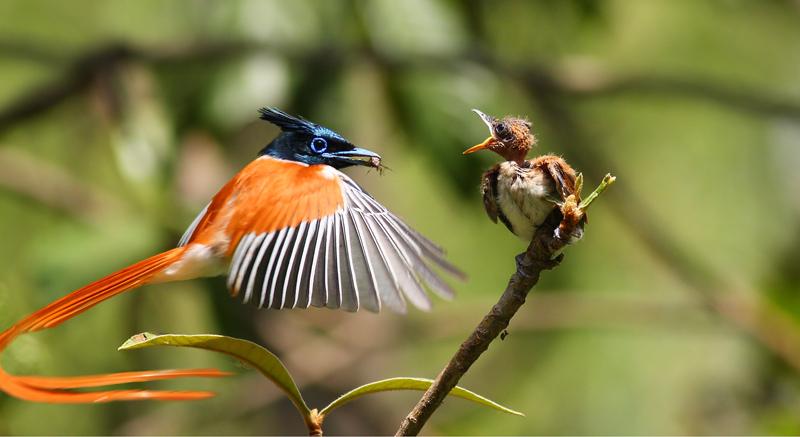
A recognized forest reserve surrounds Sigiriya Rock Fortress, which is a great location for bird watching. As a UNECO World…

